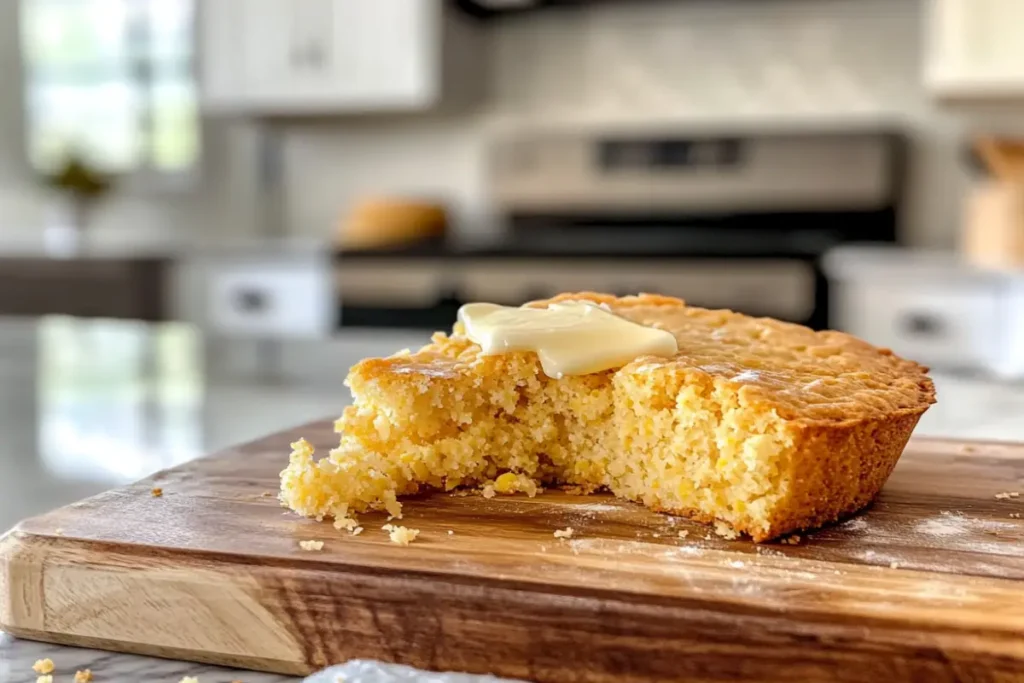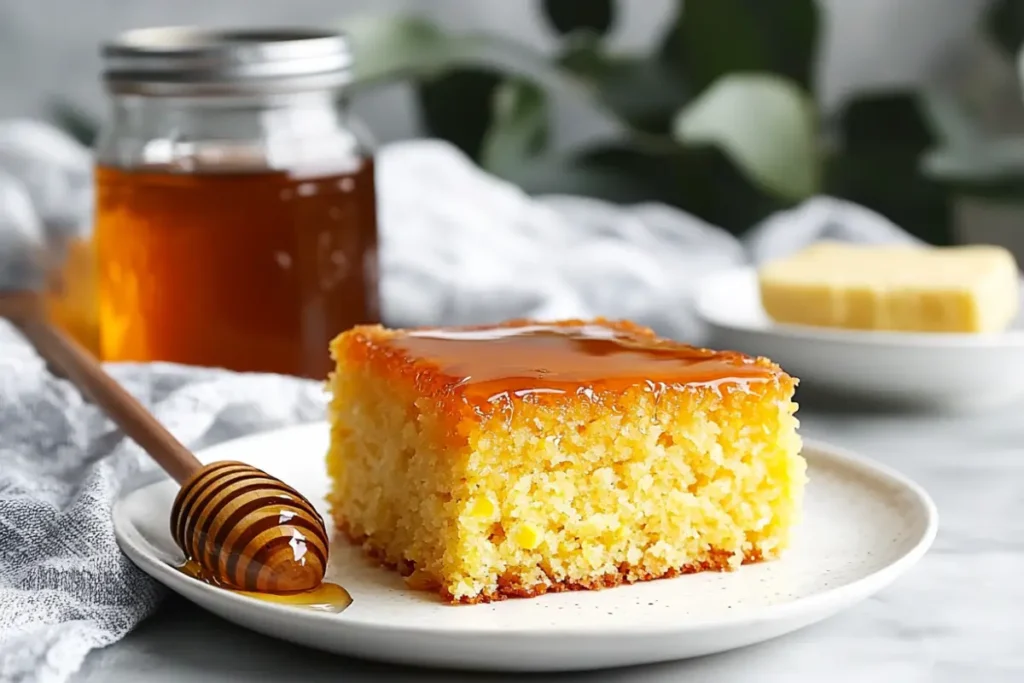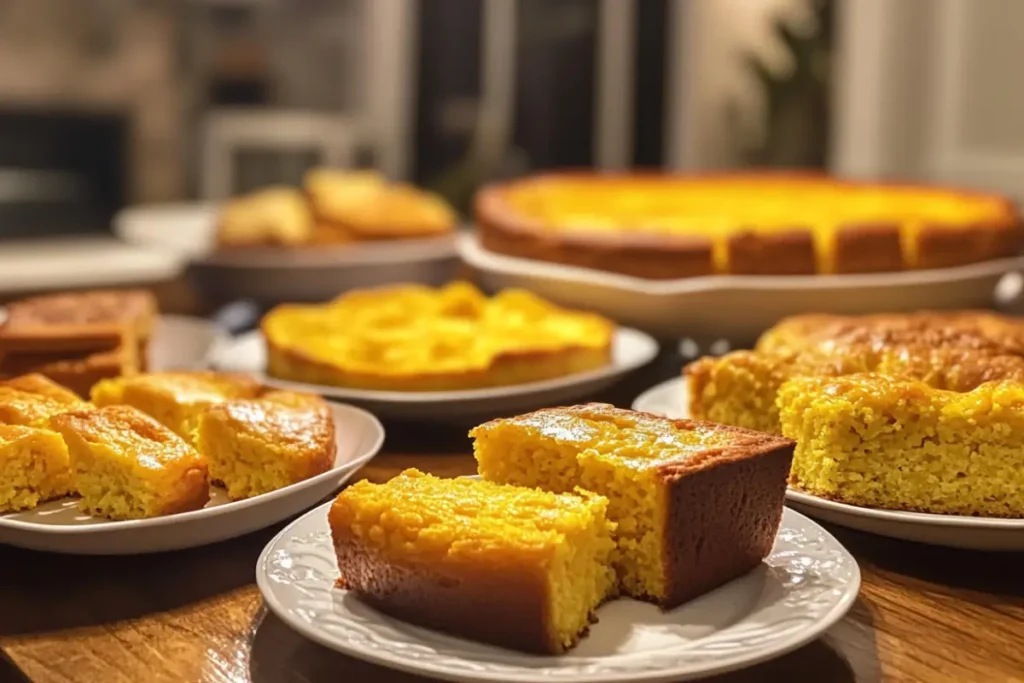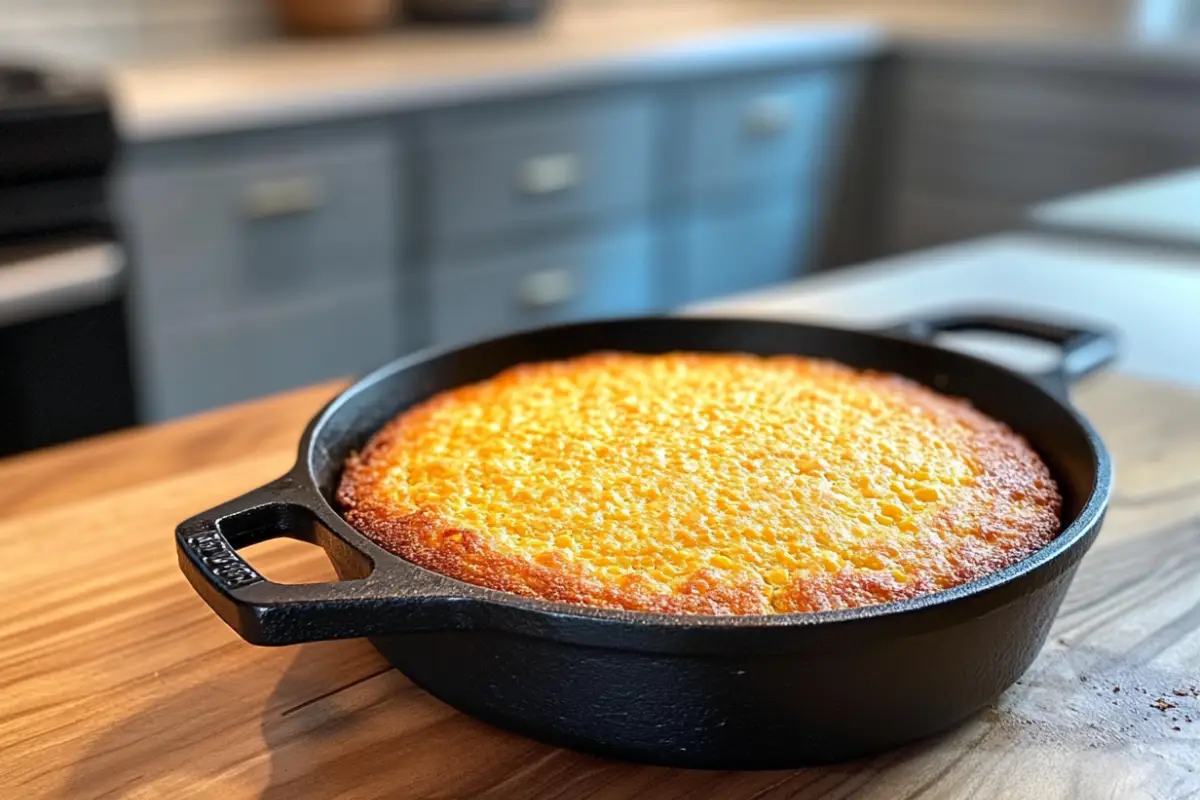Last Updated on February 12, 2025 by Souhail
Cornbread is one of those iconic dishes that feels deeply rooted in tradition. But did you know that the style of cornbread you enjoy says a lot about where you’re from? The two most famous types of cornbread—Southern cornbread and sweet cornbread—are more than just regional preferences; they embody cultural, historical, and even culinary differences that have developed over centuries.
In this article, we’ll break down the key distinctions between Southern cornbread and sweet cornbread, covering everything from ingredients to texture, taste, and cooking methods. Whether you’re new to cornbread or just curious about its variations, this guide will answer all your questions.
Table of contents
- Southern Cornbread vs. Sweet Cornbread: A Quick Comparison
- What Is Southern Cornbread?
- What Is Sweet Cornbread?
- Why the Difference? The Historical and Cultural Context
- Which Type of Cornbread Should You Choose?
- Common Variations of Cornbread
- Pro Tips for Making Perfect Cornbread
- Storage and Reheating Tips
- Health Benefits of Cornbread: Is One Version Healthier?
- Cornbread Across the U.S.: Regional Variations Beyond Southern and Sweet
- FAQs About Cornbread Differences
- Final Toughts
Southern Cornbread vs. Sweet Cornbread: A Quick Comparison
At its core, Southern cornbread is savory, rustic, and made without added sugar, whereas sweet cornbread has a lighter, cake-like texture and contains sugar or sweeteners. Let’s dive into the specifics:
| Feature | Southern Cornbread | Sweet Cornbread |
|---|---|---|
| Flavor | Savory, sometimes slightly tangy | Sweet, like a cross between cake and bread |
| Texture | Dense, crumbly, rustic | Moist, fluffy, cake-like |
| Color | Golden or yellow | Lighter, often paler |
| Traditional Fat Used | Bacon grease, lard, or butter | Butter or vegetable oil |
| Leavening Agent | Baking powder, sometimes baking soda | Baking powder |
| Sweetener | None (traditionally) | Sugar, honey, or maple syrup |
What Is Southern Cornbread?
Southern cornbread is a traditional, no-frills bread that has been a staple in the southern United States for generations. It’s meant to be savory, not sweet, and typically pairs with meals like fried chicken, collard greens, and beans. Southern cooks pride themselves on making cornbread that’s crispy on the outside and crumbly on the inside, often using a cast-iron skillet to achieve that perfect crust.

Key Characteristics of Southern Cornbread:
- No Sugar
Traditional Southern cornbread doesn’t contain sugar. This is one of the most notable differences from its sweeter counterpart. Southern cooks often argue that adding sugar turns it into a cake rather than cornbread. - Use of Cornmeal
Southern cornbread relies heavily on stone-ground cornmeal, which gives it a coarser texture. The cornmeal can be white or yellow, but yellow cornmeal is more common. - Bacon Grease or Lard
A hallmark of authentic Southern cornbread is the use of bacon grease or lard instead of vegetable oil or butter. This adds a savory depth of flavor and helps create a crispy crust. - Cast-Iron Skillet Cooking
Traditional Southern cornbread is typically cooked in a hot cast-iron skillet. Heating the skillet before adding the batter ensures a golden, crispy crust, which is a signature of Southern-style cornbread.
What Is Sweet Cornbread?
Sweet cornbread is often associated with Northern and Western U.S. cuisines, where cooks prefer a lighter, fluffier bread with a sweet flavor. It’s more cake-like in texture, making it an ideal side dish for chili, barbecue, or even served with a pat of butter and honey.

Key Characteristics of Sweet Cornbread:
- Sugar or Sweeteners
The defining feature of sweet cornbread is the addition of sugar. Recipes can vary, but sweet cornbread often includes white sugar, brown sugar, honey, or maple syrup. - Flour-to-Cornmeal Ratio
Sweet cornbread has a higher ratio of flour to cornmeal, which creates a softer, less crumbly texture compared to Southern cornbread. - Butter or Vegetable Oil
Unlike Southern cornbread, which traditionally uses bacon grease or lard, sweet cornbread recipes often call for butter or vegetable oil, contributing to a moister, richer texture. - Baking Method
Sweet cornbread is often baked in a square or round baking dish instead of a skillet. The result is a uniform, golden loaf with a tender crumb.
Why the Difference? The Historical and Cultural Context
The difference between Southern cornbread and sweet cornbread can be traced back to regional agricultural practices and cultural preferences.
Southern Tradition: Savory Cornbread
In the South, corn was a staple crop, and families relied on stone-ground cornmeal to make their daily bread. Sugar was expensive and scarce in many areas, so cornbread remained a simple, savory dish that used basic pantry ingredients like cornmeal, buttermilk, and lard.
Northern Influence: Sweet Cornbread
In contrast, Northern and Western regions had greater access to refined flour and sugar, which influenced their baking styles. Over time, cornbread recipes in these areas became sweeter and softer, evolving into the sweet cornbread we know today.
Which Type of Cornbread Should You Choose?
The choice between Southern cornbread and sweet cornbread ultimately comes down to personal preference and the meal you’re serving.
When to Choose Southern Cornbread:
- Perfect with savory dishes like beans, collard greens, and fried chicken.
- Ideal for dunking into stews or soups.
- Great for those who prefer a less sweet, more rustic bread.
When to Choose Sweet Cornbread:
- Best served alongside chili, barbecue, or pulled pork.
- Great as a standalone snack or side dish with butter and honey.
- Perfect for those who prefer a cake-like, sweet flavor in their bread.
Common Variations of Cornbread
Both Southern and sweet cornbread have numerous variations depending on the region and the cook’s preferences. Here are some popular ones:
- Buttermilk Cornbread: Common in the South, this uses tangy buttermilk to enhance the flavor.
- Honey Cornbread: A sweeter version that uses honey instead of sugar for a more natural sweetness.
- Jalapeño Cornbread: Adds diced jalapeños for a spicy kick, often made with cheddar cheese.
- Corn Pudding: A sweeter, custard-like variation popular in some Southern and Midwestern regions.
Pro Tips for Making Perfect Cornbread
- Use a Cast-Iron Skillet for Southern Cornbread
To achieve that crispy crust, always preheat your cast-iron skillet before adding the batter. - Don’t Overmix the Batter
Whether making sweet or Southern cornbread, avoid overmixing the batter to keep the texture light and fluffy. - Customize the Sweetness
If you prefer something in between, adjust the sugar level to suit your taste. Start with a tablespoon and work up from there. - Use Buttermilk for Flavor
Using buttermilk instead of regular milk adds a tangy flavor that complements both sweet and savory versions.
Storage and Reheating Tips
Cornbread, whether sweet or Southern, can be stored and reheated easily:
- Refrigerate: Store in an airtight container for up to 5 days.
- Freeze: Cornbread freezes well. Wrap individual pieces in plastic wrap and store in a freezer bag for up to 3 months.
- Reheat: To maintain moisture, wrap in foil and warm in the oven at 350°F (175°C) for about 10 minutes.
Health Benefits of Cornbread: Is One Version Healthier?
Cornbread is often considered a comfort food, but it also offers some surprising health benefits. Whether you prefer Southern cornbread or sweet cornbread, both versions provide essential nutrients from cornmeal, though their health profiles differ based on ingredients and preparation methods.
Nutritional Benefits of Cornmeal
Both types of cornbread start with a base of cornmeal, which is made from ground dried corn. Cornmeal is naturally gluten-free and contains vitamins and minerals such as:
- Fiber: Supports digestive health and keeps you feeling full longer.
- B Vitamins: Essential for energy production and brain function.
- Magnesium: Helps regulate blood pressure and supports muscle function.
- Iron: Important for transporting oxygen throughout the body.
Cornmeal is also a good source of complex carbohydrates, which provide slow-releasing energy without causing blood sugar spikes.
Southern Cornbread: The Healthier Option?
Many argue that traditional Southern cornbread is the healthier choice because it doesn’t contain added sugar. Here’s why:
- Lower in Sugar: Southern cornbread is savory, which means it avoids the potential downsides of excess sugar intake, such as increased risk of diabetes, weight gain, and heart disease.
- Higher in Healthy Fats: The use of bacon grease, lard, or butter in Southern cornbread provides saturated fats that can contribute to heart health in moderation. Plus, cooking in a cast-iron skillet can add a small amount of iron to your diet.
- Less Processed Flour: Southern cornbread uses less all-purpose flour than sweet cornbread, making it slightly more nutrient-dense.
However, Southern cornbread’s use of animal fats can be a concern if consumed in excess, particularly for those watching their cholesterol intake.
Sweet Cornbread: When Moderation Is Key
Sweet cornbread tends to be higher in calories and sugar, especially when recipes include white sugar, brown sugar, honey, or maple syrup. This can make it less ideal for those who are managing blood sugar levels or trying to reduce refined sugar intake.
However, sweet cornbread also has some redeeming qualities:
- Higher Moisture Content: Sweet cornbread’s higher ratio of butter or vegetable oil can make it more palatable for some people, especially children or those with a sweet tooth.
- Customizable Sweeteners: You can make sweet cornbread healthier by swapping refined sugar for natural sweeteners like honey or maple syrup, which have a lower glycemic index.
Is One Version Better for You?
The healthiest version of cornbread really depends on your personal health goals and dietary needs.
- If you’re looking to cut back on sugar and prefer a low-carb option, Southern cornbread is likely the better choice.
- If you’re craving something more indulgent or need a quick source of energy, sweet cornbread can be a satisfying option, especially with healthier substitutions like whole wheat flour or natural sweeteners.
For a balanced approach, you can also create a hybrid version by reducing the sugar in a sweet cornbread recipe or adding a touch of honey to a traditional Southern recipe.
Cornbread Across the U.S.: Regional Variations Beyond Southern and Sweet

While Southern cornbread and sweet cornbread are the two most well-known versions, there are several regional variations of cornbread across the United States. These variations clearly highlight the diverse ways different communities have made cornbread their own, skillfully adapting the basic recipe to fit both local ingredients and regional preferences over time.
Let’s explore some unique cornbread styles found across the country:
1. Hot Water Cornbread (Southern Tradition)
A staple in rural Southern communities, hot water cornbread is made with cornmeal, salt, and boiling water, then shaped into patties and fried in oil.
- Texture: Dense and crispy on the outside, soft inside.
- Flavor: Savory with a mild, nutty flavor.
- Unique Feature: It doesn’t use any leavening agents like baking powder or baking soda.
This version of cornbread was born out of necessity in impoverished areas, where families had to make do with what they had. It remains a beloved side dish, especially in soul food cuisine.
2. Skillet Cornbread (Appalachian and Southern U.S.)
This is the classic Southern-style cornbread cooked in a cast-iron skillet. The skillet is heated in the oven or on the stovetop before the batter is poured in, creating a crispy, golden crust.
- Texture: Crumbly and dense with a crispy edge.
- Flavor: Savory with a rich, buttery taste.
- Unique Feature: Often uses buttermilk for a tangy flavor and is baked without sugar.
Skillet cornbread is often served alongside greens, beans, or stews, making it a versatile side dish.
3. Northern Cornbread (New England and Midwest)
In Northern states, cornbread tends to be lighter, fluffier, and sweeter than Southern versions.
- Texture: Soft and cake-like.
- Flavor: Sweet, similar to a muffin.
- Unique Feature: Contains more flour and sugar, giving it a milder corn flavor.
This style of cornbread is often served as a side dish for chili or barbecue, and it pairs well with honey butter.
4. Spoonbread (Appalachian and Mid-Southern U.S.)
Spoonbread is a custard-like variation of cornbread that is soft, fluffy, and served with a spoon (hence the name). It’s more like a pudding or soufflé than traditional cornbread.
- Texture: Light, airy, and creamy.
- Flavor: Mildly sweet with a rich corn flavor.
- Unique Feature: Made with more eggs and milk, resulting in a softer, more delicate texture.
Spoonbread is often served as a holiday dish or at special gatherings, offering a more refined version of cornbread.
5. Corn Dodgers (Western U.S.)
Corn dodgers were a favorite among cowboys and pioneers in the Old West. These are small, baked or fried cornmeal cakes that are easy to transport.
- Texture: Dense and chewy.
- Flavor: Mild, savory.
- Unique Feature: Traditionally served with molasses or syrup as a sweetener.
Corn dodgers were practical travel food, providing sustenance on long journeys across the plains.
6. Johnnycakes (New England and Caribbean)
Johnnycakes are thin, fried cornbread pancakes that trace their origins to Native American cuisine. They are still popular in New England and the Caribbean.
- Texture: Crisp on the outside, soft inside.
- Flavor: Mild and slightly sweet.
- Unique Feature: Made with only cornmeal, water, and salt, often fried in pork fat.
Johnnycakes are typically served for breakfast with butter, syrup, or jam.
FAQs About Cornbread Differences
Traditionally, Southern cornbread is not sweet, but sweet cornbread is popular in Northern regions. It all depends on personal preference.
Southern cornbread is savory, rustic, and pairs well with hearty dishes. Many people prefer it because of its crispy crust and crumbly texture.
While sweet cornbread is sweeter and more cake-like, it still contains cornmeal and has a slightly grainy texture, distinguishing it from regular cake.
Absolutely! If you’re making Southern-style cornbread, simply leave out the sugar and use bacon grease or lard for a more authentic taste.
Final Toughts
The difference between Southern and sweet cornbread goes beyond taste, reflecting regional traditions and unique cooking methods passed down over generations. Southern cornbread is savory with a crumbly texture, while sweet cornbread is moist and cake-like with a hint of sweetness.
If you’re looking for a rustic side dish to complement hearty, savory meals, Southern cornbread is your best bet. But if you’re in the mood for something sweet and comforting to enjoy with barbecue or chili, sweet cornbread might be more your style.
Ultimately, there’s no right or wrong way to enjoy cornbread—because it all comes down to what makes you feel at home and brings comfort to your table. So, why not try both styles and discover which version you truly love the most? After all, cornbread is as versatile as it is timeless. Whether savory or sweet, it’s a delicious slice of culinary history that continues to bring people together at tables across the country.
If you’ve enjoyed learning about the differences between these cornbread styles, be sure to explore more Southern cooking traditions like hearty stews and flavorful greens. Additionally, check out classic side dishes that pair perfectly with cornbread. Whether sweet or savory, cornbread is a timeless favorite that brings warmth to any table. Happy baking!
If you’re excited to try a new twist on traditional cornbread, don’t miss our Easy Sweet Potato Cornbread Recipe for a Crowd-Pleasing Treat. This unique version combines the rich, earthy flavor of sweet potatoes with the classic texture of cornbread, making it a perfect choice for holiday gatherings, potlucks, or family dinners. Whether you prefer Southern or sweet cornbread, this recipe is sure to impress everyone at your table!

